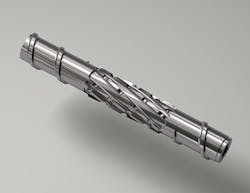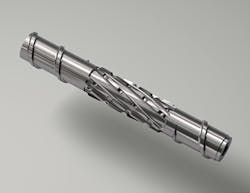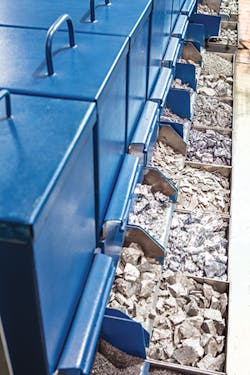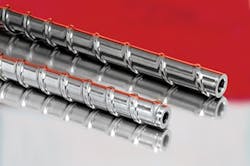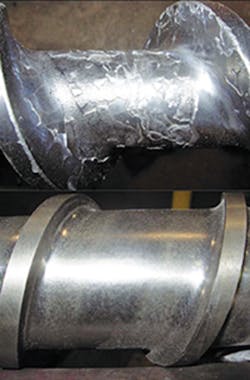Enhancements in screws, barrels, valves shine at NPE
Controlled melt temperature, better mixing, improved melt quality, shorter recovery times and extended life are some of the benefits touted by the crop of screws, barrels, valves and related components demonstrated for injection molding at last month's NPE.
MIX IT UP
Reiloy USA, Wichita, Kan., unveiled a new mixing screw design that allows the feed screw to be configured as an aggressive high shear mixer or easy low shear mixer.
The core design of the as-yet unnamed screw has three areas of adjustment within the mixing section that permit its operation as a distributive or dispersive mixer, says Dave Larson, president of Reiloy USA, formerly known as Reiloy Westland.
"Changing minor design variables that are within the mixer section itself yields significant changes in the mixing screw's function. We can change the compression ratio, or change the shear of the resin by adjusting the barrier undercut. We can control the flow through the mixer by adjusting the notches in the mixer section. "We can also adjust the number of flights to accommodate the resin being processed," says Larson. Reiloy USA can configure the screw with two inlet and two outlet channels and up to six inlet and six outlet channels.
Reiloy USA can also adjust one or all four of the adjustable features within the mixing section of the screw. The wide latitude of adjustment offered by the screw allows users to better dial-in screw configuration to the polymer being run, and presents an opportunity for the processor to run a screw that successfully processes resins as rheologically divergent as ABS and nylon, says Larson.
The new mixing screw is distinct from the company's Eagle line of mixing screws. The new flexible screw has greater adjustment capability than the Eagle mixer, says Larson.
Troisdorf, Germany-based Reiloy Metall's expertise in metallurgy also has led to a new offering regarding hard surfacing materials used in the making of welded screws. RC3 is a new proprietary line of custom-configured metal alloys that extend wear and corrosion resistance better than conventional metals available commercially. Reiloy Metall manufactures the metal powders itself from a range of metal ores, including nickel and cobalt, rather than machining metal alloys produced from an outside source. This allows Reiloy Metall to control the quality of the product, giving both it and Reiloy USA the opportunity to create customized formulations.
Later this year Reiloy USA is moving from a 27,000-square-foot facility in Wichita to a new 55,000-square-foot building eight miles away in Maize, Kan. The shop will house a new seven-axis multi-purpose machine center from Weingärtner Maschinenbau GmbH, Kirchham, Austria, that is the first unit made for producing both screws and barrels.
FIGHT CORROSION
Zeiger Industries Inc., Canton, Ohio, a manufacturer of check ring valves and through-hardened tool steel screws, has improved the corrosion resistance of the Mallard Z4 non-return/check ring valve used for high-speed processing of filled materials that have corrosive properties.
Zeiger introduced its new Connector line of Mallard Z4 valves that, for the first time, combines its proprietary tungsten carbide wear surface technology with the wear and corrosion resistance of either CPM 20CV or CPM S90V. Both base materials are supplied by Latrobe Steel and are vanadium-bearing stainless tool steels manufactured using Crucible Particle Metallurgy (CPM), says Stan Glover, Zeiger's sales director.
"Processors have had to change check rings made by competing suppliers after just 36 hours of use, because the corrosive attack from processing was so severe it caused the check ring to stop performing. With the new Z4 connector valve, the check ring has operated trouble-free for more than a year," says Glover.
Zeiger has started offering Latrobe Steel's CPM 20CV stainless tool steel as a high-end material for valves and screws. CPM 20CV delivers excellent corrosion resistance and good wear resistance, and is an alternative to CPM S90V, which offers excellent wear resistance and good corrosion resistance, he says.
Zeiger also highlighted its continuous taper front-end design that reduces material stagnation and potential degradation seen with straight bore end cap and nozzle designs. The continuous taper design is well-suited to the processing of clear PC, technical rigid PVC components and fire-retardant-based materials, and is designed to be self-cleaning, which minimizes material stagnation. The continuous taper design has been available for some time but now features Böhler Uddeholm's Elmax powder metallurgical (PM) stainless steel that provides better release of the materials being processed, says Glover.
The design includes the screw tip, end cap, nozzle and nozzle tip. Molders can add these components to an existing machine to convert the press from a straight bore to a continuous taper bore.
"The self-cleaning aspect of the tapered bore minimizes the occurrence of black specks when processing clear PC," says Glover. The Mallard Z4, which is used with the continuous taper design, is also made of the Elmax material.
Zeiger updated its easy-conversion molding kit for liquid silicone rubber that it introduced at NPE 2012 to simplify installation and use and enhance performance. The LSR molding Plug-n-Play Conversion kit lets a molder turn a thermoplastic injection press into a machine that processes two-component thermosetting LSR.
The kit is comprised of a barrel and screw, pre-closed check ring assembly and water-cooled shut-off nozzle, as well as a seal kit that keeps the LSR from exiting the back of the screw during processing, says Glover.
"Users only need to make minor machine programming changes, move some heater band circuits to the mold side of the machine, and they are ready to run," says Glover. A stand-alone kit was on display at NPE. Zeiger can produce LSR systems featuring screws from 12mm to 65mm in diameter, but most conversion kits fall in the traditional LSR system range of between 14mm and 30mm.
Zeiger also exhibited its multi-material Zeiger Performance (ZP) screw as a direct replacement to customers using a general-purpose (GP) screw. The ZP screw can process a range of materials more efficiently than a GP-style screw and is optimized to process a single material or a family of resins. Glover says the ZP is a low shear design that uses the heat from the barrel rather than the heat of an aggressive compression zone (used in a GP screw). This design lowers the mechanical stress applied to the resin and routinely reduces the processor's cycle times.
FOR PROLIFIC PACKAGING PRODUCTION
Nordson Xaloy Inc., New Castle, Pa., introduced its new Quantum barrier screw for high-volume production of enhanced quality melt at high rates for injection molded thin-wall packaging. The modified geometry of the screw's barrier section increases heat energy efficiency on unmelted material for higher rates of plasticizing taking place against the barrel wall. Molten material flows over the barrier flight (which is undercut 0.03 to 0.06 inch) and into a deep, low shear channel, says Tony Genova, supervisor of product engineering for screws at the company's Youngstown, Ohio, plant.
The barrier improves melting efficiency and the deeper melt channel controls melt temperature, while reducing screw recovery times when compared to existing high-performance screw designs, says Genova.
The Quantum screw can be used with a range of existing or new barrel designs; however, a grooved-barrel improves solids conveying to optimize performance, says Genova. The new screw was shown with Nordson's existing poppet-style non-return valve, which is designed to enhance processing performance and has free-flowing channels that prevent material degradation and a rapid shut-off for shot-to-shot consistency. The screw is ideally suited for injection presses of 400 tons and above, which are typically employed for high-speed packaging applications, says Genova.
Nordson's X8000 abrasion-resistant coating technology for screw encapsulation and its X800 abrasion-resistant technology for barrel inlays have been combined into a single package that offers extended equipment life for processors molding with highly filled compounds and high-temperature engineering polymers.
Both technologies have been available independently for several years. Nordson manufactures the abrasion-resistant coating from a nickel-based alloy with high tungsten carbide content. X8000 fuses the coating to the screw in a two-step process that forms a metallurgical bond. X800 barrel inlay is more wear resistant than iron-based and nickel-cobalt alloys, says Genova.
ENERGY-EFFICIENT PLASTICATION
Robert Barr Inc., Virginia Beach, Va., has two patents pending for its Energy Transfer (ET) family of screws that focus on improving performance and increasing screw life, says President Jeff Myers. Officials say current design research at Barr's Onsted, Mich., testing lab is focused on extending the performance capabilities of its ET and Variable Barrier Energy Transfer (VBET) line of screws.
The screws have undergone testing to better manage the energy used to melt polymer.
The VBET and ET screws are licensed exclusively to Milacron LLC, Batavia, Ohio, in North America for its injection molding machines, and to a major machine manufacturer in Italy for its PET machines.
PET preform production and PET strapping are new market applications seeing a rise in demand for the VBET screw, where its low shear design delivers low acetaldehyde levels in the production of PET preforms, and minimizes intrinsic viscosity drop, keeping the strength in PET strapping products, says Myers.
REDESIGN, POST PATENT
Tim Womer, inventor of the Fusion screw, Pulsar II screw, and designer of roughly 8,000 custom-made single-feed screw designs for injection molding and extrusion, is investigating ways to update proven technologies with patents that have expired or are expiring. Womer, holder of 15 patents involving various aspects of polymer processing technology, is developing a redesigned Maddock spiral CC mixer that solves a common issue with the widely used component.
"Users who have experienced high melt temperature when processing materials with the mixer attribute the issue to the barrier gap (between the channel for unmelted solids and molten polymer) being too tight," Womer says. If the barrier is opened up, the consequence is a reduction in the amount of shear over the barrier flight.
"If there are unmelts or gels in the channel, those solid materials will not see the amount of shear stress needed," Womer says.
He is one of several people involved in an intense mixing study being conducted on the Maddock mixer design, and he has already built seven prototype versions. Real-time testing at commercial rates of production will evaluate melt temperature, melt quality and other aspects to verify and validate a new model. Womer operates TWWomer & Associates LLC, Edinburg, Pa., as a consultant and designer of customized screw, barrel and component designs.
Mikell Knights, senior correspondent
Contacts:
Nordson Xaloy Inc.,
724-656-5600, www.xaloy.com
Reiloy USA,
316-721-1144, www.reiloyusa.com
Robert Barr Inc.,
757-428-4032, www.robertbarr.com
TWWomer & Associates LLC,
724-355-3311, www.twwomer.com
Zeiger Industries Inc.,
330-484-4413, www.zeigerindustries.com
